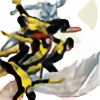HOME | DD
 melvynyeo — Spitting Spider with Wasp prey
melvynyeo — Spitting Spider with Wasp prey

Published: 2013-11-12 12:16:17 +0000 UTC; Views: 5613; Favourites: 135; Downloads: 67
Redirect to original
Description
Surprisingly, this is my first spitting spider with prey shot... and the same night i found 2 with prey





 Taken at night in Singapore.
Taken at night in Singapore.Quote from en.wikipedia.org/wiki/Spitting…
Spitting spiders are members of the family Scytodidae. There are several genera, of which Scytodes is the best-known. Over 150 species of scytodids have been described worldwide. This means that the Scytodes is somewhat related to the family Sicariidae commonly known as Recluse spiders being that they are part of the same superfamily.
Scytodidae catch their prey by spitting a fluid that congeals on contact into a venomous and sticky mass. Remarkably, though it is produced in venom glands in the chelicerae, the fluid contains both venom and spider silk in liquid form. The venom-impregnated silk not only immobilizes prey such as Silverfish by tying it down, but has a venomous effect as well. In high-speed moving pictures, the spiders can be observed swaying from side to side as they "spit", catching the prey in a crisscrossed "Z" pattern; it is criss-crossed because each of the chelicerae emits half of the pattern. The spider usually strikes from a distance of 10-20 mm and the whole attack sequence is over in a little under 1/700th of a second.[1] After making the capture, the spider will typically bite the prey with venomous effect, and wrap it in the normal spider fashion with silk from the spinnerets.
Like the Sicariidae and Diguetidae these spiders are haplogyne (lack hardened female genitalia) and have six eyes, which are arranged as three pairs. The Scytodidae differ from the Sicariidae and Diguetidae in having a dome-shaped carapace and in their characteristic flecked pattern of spots.
When two scytodes happen to fight each other, the larger one generally is strong enough to break free from the web of the smaller, and thereby to win.[3] However, at least some species exhibit presocial behaviour, in which mature spiders live together and assist the young with food.
Related content
Comments: 11

This is for all the spiders that fell victims to wasps
👍: 0 ⏩: 0

Nice! Never saw one with prey. Recently saw my first spitter. Had never even heard of them previously. I'd been keeping a huntsman spider with egg sack and the slings were just starting to emerge. In going through the enclosure to find a lone baby to photograph I discovered a very small spitting spider! How it got there I'll never know. Must have found its way into the house and somehow into the sealed container.
👍: 0 ⏩: 0

haha it looks so nonchalant about its line of work.
👍: 0 ⏩: 0

This is fabulous! Never knew spiders shoot their "web" and poison at the same time. Amazing!
👍: 0 ⏩: 0

Such an epic shot, you captured it perfectly here!
👍: 0 ⏩: 0

Yay the spider won 
👍: 0 ⏩: 0























